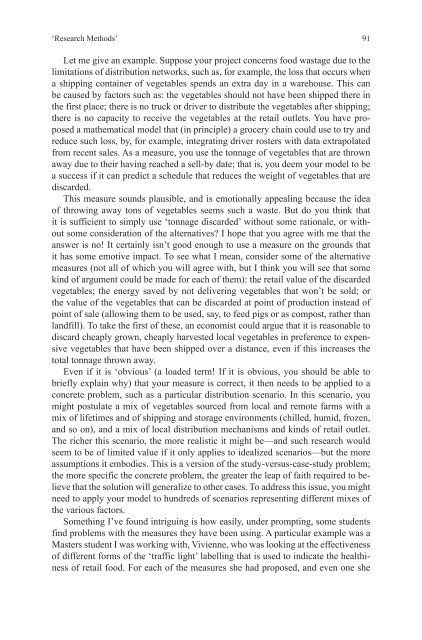How-to-Write-a-Better-Thesis
You also want an ePaper? Increase the reach of your titles
YUMPU automatically turns print PDFs into web optimized ePapers that Google loves.
‘Research Methods’<br />
<br />
91<br />
Let me give an example. Suppose your project concerns food wastage due <strong>to</strong> the<br />
limitations of distribution networks, such as, for example, the loss that occurs when<br />
a shipping container of vegetables spends an extra day in a warehouse. This can<br />
be caused by fac<strong>to</strong>rs such as: the vegetables should not have been shipped there in<br />
the first place; there is no truck or driver <strong>to</strong> distribute the vegetables after shipping;<br />
there is no capacity <strong>to</strong> receive the vegetables at the retail outlets. You have proposed<br />
a mathematical model that (in principle) a grocery chain could use <strong>to</strong> try and<br />
reduce such loss, by, for example, integrating driver rosters with data extrapolated<br />
from recent sales. As a measure, you use the <strong>to</strong>nnage of vegetables that are thrown<br />
away due <strong>to</strong> their having reached a sell-by date; that is, you deem your model <strong>to</strong> be<br />
a success if it can predict a schedule that reduces the weight of vegetables that are<br />
discarded.<br />
This measure sounds plausible, and is emotionally appealing because the idea<br />
of throwing away <strong>to</strong>ns of vegetables seems such a waste. But do you think that<br />
it is sufficient <strong>to</strong> simply use ‘<strong>to</strong>nnage discarded’ without some rationale, or without<br />
some consideration of the alternatives? I hope that you agree with me that the<br />
answer is no! It certainly isn’t good enough <strong>to</strong> use a measure on the grounds that<br />
it has some emotive impact. To see what I mean, consider some of the alternative<br />
measures (not all of which you will agree with, but I think you will see that some<br />
kind of argument could be made for each of them): the retail value of the discarded<br />
vegetables; the energy saved by not delivering vegetables that won’t be sold; or<br />
the value of the vegetables that can be discarded at point of production instead of<br />
point of sale (allowing them <strong>to</strong> be used, say, <strong>to</strong> feed pigs or as compost, rather than<br />
landfill). To take the first of these, an economist could argue that it is reasonable <strong>to</strong><br />
discard cheaply grown, cheaply harvested local vegetables in preference <strong>to</strong> expensive<br />
vegetables that have been shipped over a distance, even if this increases the<br />
<strong>to</strong>tal <strong>to</strong>nnage thrown away.<br />
Even if it is ‘obvious’ (a loaded term! If it is obvious, you should be able <strong>to</strong><br />
briefly explain why) that your measure is correct, it then needs <strong>to</strong> be applied <strong>to</strong> a<br />
concrete problem, such as a particular distribution scenario. In this scenario, you<br />
might postulate a mix of vegetables sourced from local and remote farms with a<br />
mix of lifetimes and of shipping and s<strong>to</strong>rage environments (chilled, humid, frozen,<br />
and so on), and a mix of local distribution mechanisms and kinds of retail outlet.<br />
The richer this scenario, the more realistic it might be—and such research would<br />
seem <strong>to</strong> be of limited value if it only applies <strong>to</strong> idealized scenarios—but the more<br />
assumptions it embodies. This is a version of the study-versus-case-study problem;<br />
the more specific the concrete problem, the greater the leap of faith required <strong>to</strong> believe<br />
that the solution will generalize <strong>to</strong> other cases. To address this issue, you might<br />
need <strong>to</strong> apply your model <strong>to</strong> hundreds of scenarios representing different mixes of<br />
the various fac<strong>to</strong>rs.<br />
Something I’ve found intriguing is how easily, under prompting, some students<br />
find problems with the measures they have been using. A particular example was a<br />
Masters student I was working with, Vivienne, who was looking at the effectiveness<br />
of different forms of the ‘traffic light’ labelling that is used <strong>to</strong> indicate the healthiness<br />
of retail food. For each of the measures she had proposed, and even one she














![[Lonely Planet] Sri Lanka](https://img.yumpu.com/59845622/1/169x260/lonely-planet-sri-lanka.jpg?quality=85)


